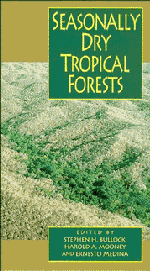Book contents
- Frontmatter
- Contents
- List of contributors
- Acknowledgements
- 1 Introduction
- 2 Dry forests of Central America and the Caribbean
- 3 Overview of the Brazilian caatinga
- 4 Savannas, woodlands and dry forests in Africa
- 5 Dry forest ecosystems of Thailand
- 6 The Cenozoic record of tropical dry forest in northern Latin America and the southern United States
- 7 Diversity and floristic composition of neotropical dry forests
- 8 Vertebrate diversity, ecology and conservation in neotropical dry forests
- 9 Diversity of life forms of higher plants in neotropical dry forests
- 10 Drought responses of neotropical dry forest trees
- 11 Plant reproduction in neotropical dry forests
- 12 Plant–herbivore interactions in Mesoamerican tropical dry forests
- 13 Biomass distribution and primary productivity of tropical dry forests
- 14 Nutrient cycling in tropical deciduous forests
- 15 Biology of the belowground system of tropical dry forests
- 16 Nitrogen trace gas emissions in a tropical dry forest ecosystem
- 17 Conversion of tropical dry forest to pasture and agriculture
- 18 Ethnobotany of the Mexican tropical dry forests
- Index
3 - Overview of the Brazilian caatinga
Published online by Cambridge University Press: 07 September 2010
- Frontmatter
- Contents
- List of contributors
- Acknowledgements
- 1 Introduction
- 2 Dry forests of Central America and the Caribbean
- 3 Overview of the Brazilian caatinga
- 4 Savannas, woodlands and dry forests in Africa
- 5 Dry forest ecosystems of Thailand
- 6 The Cenozoic record of tropical dry forest in northern Latin America and the southern United States
- 7 Diversity and floristic composition of neotropical dry forests
- 8 Vertebrate diversity, ecology and conservation in neotropical dry forests
- 9 Diversity of life forms of higher plants in neotropical dry forests
- 10 Drought responses of neotropical dry forest trees
- 11 Plant reproduction in neotropical dry forests
- 12 Plant–herbivore interactions in Mesoamerican tropical dry forests
- 13 Biomass distribution and primary productivity of tropical dry forests
- 14 Nutrient cycling in tropical deciduous forests
- 15 Biology of the belowground system of tropical dry forests
- 16 Nitrogen trace gas emissions in a tropical dry forest ecosystem
- 17 Conversion of tropical dry forest to pasture and agriculture
- 18 Ethnobotany of the Mexican tropical dry forests
- Index
Summary
Introduction
The dry forest and scrub vegetation in Brazil, generally called ‘caatinga’, covers an estimated area of 6–9 × 105 km2 in the northeastern region. It is conditioned by the prevailing semiarid climate, with high potential evapotranspiration throughout the year (1500–2000 mm y−1) and low rainfall (300–1000 mm y−1), which is usually concentrated in 3–5 months and is very erratic (Reddy, 1983). Drought years are common and severe droughts lasting 3–5 years have occurred every 3–4 decades.
The area has been inhabited for more than 10,000 years, mainly in the river valleys and humid mountains, but according to early colonial sources, population density was generally low. Cattle raising spread in the 18th century and still is the main economic activity. From that period on, population pressure has increased in more favorable areas, where subsistence agriculture is practised in fenced plots. Until the middle of this century, cattle roamed freely on the non-agricultural land, independently of land ownership, but most properties are now fenced.
Land productivity is low and since resources are limited and birth rates have been high, the area has been a center of continuous migration to more favorable places in the same region, mainly the coastal area, or to other regions in the country. Migration increases during catastrophic drought periods. Nonetheless, population has steadily increased in the area and most of it has remained at a bare subsistence level. Social and economic parameters are the worst in the country, from lowest per capita income to highest illiteracy.
Government efforts to foster economic development in the region have centered on the coastal area, except for large irrigation projects.
- Type
- Chapter
- Information
- Seasonally Dry Tropical Forests , pp. 35 - 63Publisher: Cambridge University PressPrint publication year: 1995
- 157
- Cited by

